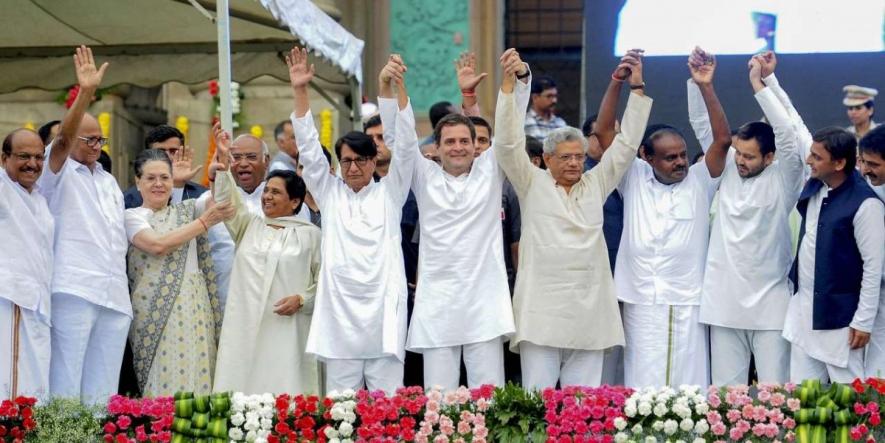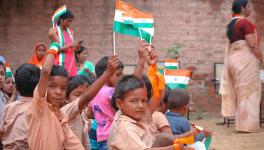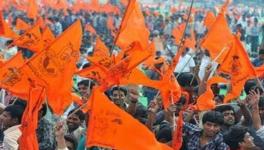Election Message: Opposition Alliance Only Check on Hindutva’s Expansion

Representational use only.Image Courtesy: The Wire
The unprecedented sweep of Gujarat by the Bharatiya Janata Party, the face-saving triumph of the Congress in Himachal Pradesh, and the victory of the Aam Aadmi Party in the Municipal Corporation of Delhi elections, along with a clutch of bye-elections, suggest four factors that will shape the battle for the 2024 Lok Sabha elections. These factors are the paramountcy of Prime Minister Narendra Modi, the sheer resilience of the BJP’s vote-bank, which soft Hindutva can't crack, and the fear of the Opposition, particularly the Congress, of elections.
First, none of the Opposition leaders can match Prime Minister Narendra Modi’s popularity and charisma. Given that elections in India have increasingly become presidential in nature, Modi gives an edge to the BJP that its rival will find hard to blunt. It is he who will spearhead, as he did in 2014 and 2019, the BJP’s campaign, which will be a combination of Hindutva and development, a term which has different meanings for different classes.
The Opposition will go to town to speak of the still-high inflation rate, the shrinking job market, and the sharply diminishing comfort of living. For many, though, development is about the welfare measures Modi has taken, no doubt borrowing the existing model of previous dispensations, but appropriating it to build the myth that his style of governance is unique. The Modi government, harnessing technology, has evolved a shade better delivery mechanism.
Yet, all this does not lead to citizens improving their life-chances autonomous of the state. In fact, they become even more dependent on the state. And dependency breeds gratitude.
For some, development is a lot about swish highways, not necessarily better healthcare or education infrastructure—and the promise he constantly holds out to make India great. This narrative of India’s greatness will deepen as the BJP will use India’s G-20 leadership to portray Modi as the foremost of world leaders. It is a riddle what benefits citizens see for themselves in India’s rising stock worldwide, imagined or real. Perhaps the pride they feel matches their euphoria at watching India’s exploits in the cricket field.
The blazing light of Hindutva, at the same time, blinds people to the failure of Modi. Hindutva is articulated right through the year, not just before every election. The method is now eight years old—target Muslims, raise mosque-temple issues, demonise Muslim rulers of yore, question the Muslim Personal Law, harass inter-faith couples, random comments threatening violence against them, park bulldozers at rallies, etc.
Or, as Home Minister Amit Shah did before the Gujarat Assembly elections, speak of how the “rioters” (read Muslims) were taught a lesson during the 2002 Gujarat riots, of which the community was a victim and abandoned by the state government. Or release those who gang-raped a Muslim woman and killed her family members, as had happened in the Bilkis Bano case. And then, after the election results are announced and the BJP wins, credit it to Modi’s vision of development.
Solid Hindu vote-bank
Second, Hindutva, rather than development, ensures the BJP’s vote-bank is not irreparably dented. It lost the MCD elections in Delhi, after controlling it for 15 years, but its vote-share increased from 36.08% to 39.09%. In what was a close fight in Himachal Pradesh, where the Congress won four more seats than the majority-mark of 35, the BJP’s vote-share was just 0.9% less than the Congress’. Had the AAP not given up on Himachal Pradesh, the Congress would have likely stumbled. In Gujarat, the BJP broke the past record of the Congress, which bagged 149 seats in 1985, and polled 52.5% of votes, an astonishing feat in a state that witnessed a triangular fight in many constituencies.
Since the chances of any party substantially denting the BJP’s vote-bank are remote, the Opposition has to ensure that non-BJP votes do not fracture.
But Opposition parties have a long history of battling against each other. For instance, is it possible for the AAP and the Congress to form an alliance in Delhi? It may be asked: Why should the AAP give one to three seats to the Congress? The answer: AAP has yet to win a Lok Sabha seat in Delhi. Will the Congress claim it is a national party and cannot be satisfied with less than four seats? Conversely, can the Congress accommodate the AAP in Gujarat, where its leader Arvind Kejriwal would also want to try his fortune in the Lok Sabha elections?
The Opposition space is hellishly fragmented. The Janata Dal (U) and the Rashtriya Janata Dal fought the bye-election in the Kurhani Assembly seat, in Bihar, together. Yet the JD (U) lost by 3,649 votes, with the Vikassheel Insaan Party (VIP) taking away 10,000 votes. Should the JD (U)-RJD accommodate the VIP, even though it may demand more seats than it can win? Again, the Rashtriya Lok Dal and Samajwadi Party came together to fight he Khatauli Assembly bye-poll. The RLD won the seat by 22,143 votes. In case the Bahujan Samaj Party had been in the fray, it is likely it would have largely netted Dalits votes, not the BJP, as they are generally reluctant to vote for the SP and RLD.
The Opposition has just 14 months to figure out the complexities of electoral arithmetic.
Soft Hindutva no answer
The BJP’s ability to hold on to its vote-share gives lie to the belief that soft Hindutva can be an antidote to Hindutva. Delhi Chief Minister and AAP leader Arvind Kejriwal maintained silence over the BJP’s habitual tormenting of Muslims over the last three years, fearing he would lose Hindu votes. At the same time, he flaunted his Hindu identity, believing Hindutva voters would desert the BJP. He lost several seats in wards affected by the 2020 riots and also in those areas which witnessed prolonged protests against the Citizenship Amendment Act. For all his manoeuvres, the BJP expanded its vote base.
But he is not only the only leader who has tried to play the soft Hindutva card. Congress leader Rahul Gandhi projected himself as a janeu-wearing Shiv Bhakt and hopped from one temple to another, particularly before the 2017 Gujarat elections. The Congress won 77 seats, up from 61 seats it had in 2012, and polled 41.44% of votes, just 2.51% more than it had in 2012. Yet, at the same time, the BJP’s vote-share increased by 1.20%, from 47.85% in 2012 to 49.05% in 2017. In Madhya Pradesh, Congress stalwarts Kamal Nath and Digvijay Singh played the soft Hindutva card with the zeal of neo-converts. They won the state so marginally that the countdown for its collapse began from the moment Kamal Nath took oath as Chief Minister.
The fear
Third, the Opposition is itself not persuaded that it can vanquish the BJP. This is symbolised by Rahul Gandhi, who has belatedly junked the Hindutva card and undertaken the Bharat Jodo Yatra, with its very clear message of challenging Modi’s polarising politics, of pitting one social group against another. Rahul’s has been a remarkable endeavour. It has certainly altered his image.
Yet he must abandon his fear of losing elections, evident from his decision to ignore the Gujarat Assembly elections. Could he not have begun his yatra from, say, Porbandar, where Mahatma Gandhi was born—and who turned the party of elites into one of the masses? It is said he wanted to disconnect the yatra from elections, perhaps calculating that a defeat would dilute the message he wished to convey. But diluted the message has been with the drubbing the Congress has received.
The yatra’s route testifies to Rahul’s fears. He spent 18 days in Kerala, where the BJP, as of now, has no chance of winning. Kerala either goes with the Congress or the Left, which would not support the BJP in case of a hung Lok Sabha. By contrast, he spent just 12 days in Madhya Pradesh, where its political bipolarity gives the Congress a chance. Sure, the Congress may want to enhance its seat tally and vote-share at the expense of potential allies. But this only reduces the chances of the Opposition building an alliance to take on the BJP, which mostly does not witness a sharp decline in its vote-share.
Rahul Gandhi may keep walking, but his gains will be limited as long as his party does not build a robust organisation, with its members sweating it out day and night until 2024 election. This is precisely what the BJP, backed by the Rashtriya Swayamsevak Sangh, does. Writer-activist Achyut Yagnik, in an interview to this writer, pointed to the invisibility of the Seva Dal in Gujarat. The Seva Dal is supposed to work for the Congress as Sangh activists do for the BJP. Rahul’s endeavour will yield gains in the long-term, beyond 2024, but then, as Keynes said, “In the long run we are all dead.”
The author is an independent journalist. The views are personal.
Get the latest reports & analysis with people's perspective on Protests, movements & deep analytical videos, discussions of the current affairs in your Telegram app. Subscribe to NewsClick's Telegram channel & get Real-Time updates on stories, as they get published on our website.
























